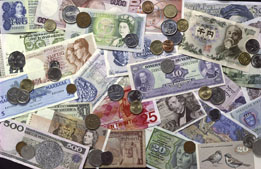Lesson 3
1. Lesson 3
Module 6: Proportional Reasoning
Lesson 3: Solving Rate Problems
Focus

Jupiterimages/Photos.com/Thinkstock
Have you ever had to exchange your money for a different currency? Maybe you have travelled to another country and needed to buy some of that country’s currency? Perhaps you have relatives in another country and they have sent you some of their money? Maybe you had to exchange Canadian dollars for currency in peso, pound, euro, zloty, franc, real, lev, yuan, colon, birr, gourde, rupee, shilling, or yen.
You have probably heard news anchors on TV mention how the Canadian dollar rose or fell against the U.S. dollar or another nation’s currency on any given day. As you saw in Lesson 1, the value of a nation’s currency is expressed as a rate that compares it to another nation’s currency. For example, the following rates show how much one Canadian dollar was worth on a given day compared to each of the following currencies:
- 1:00 Cdn : 1.004 17 U.S.
- 1.00 Cdn : 0.628 190 GBP
- 1.00 Cdn : 12.1396 MXN
- 1.00 Cdn : 45.5222 INR
Did You Know?
So, on this particular day, one Canadian dollar is worth 1.004 17 U.S. dollars, 0.628 190 Great Britain pounds, 12.1396 Mexican pesos, and 45.5222 Indian rupees. Exchange rates are constantly changing as they are determined by the market.
When going on a vacation or moving to a different country, having that nation’s currency is important. People also take the exchange rate into account when they are making purchases in another country. If you need to transfer a large amount of funds from one currency to another, the exchange rate is particularly important. A small change in the exchange rate can have a big influence on the total cost of exchanging a large amount of money.
This lesson will help you answer the following inquiry question:
- How can different strategies be used to analyze and solve problems that involve rates?
Assessment
- Lesson 3 Assignment
- Module 6 Project: Part 1
All assessment items you encounter need to be placed in your course folder.
Save a copy of the Lesson 3 Assignment to your course folder. You will receive more information about how to complete the assignment later in this lesson.
In this lesson you will also be directed to work on Part 1 of the Module 6 Project. You will find a link later in this lesson that will take you to the Module 6 Project.
Materials and Equipment
- graphing calculator